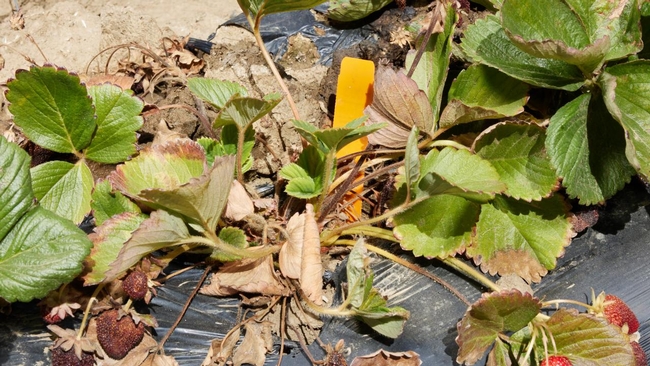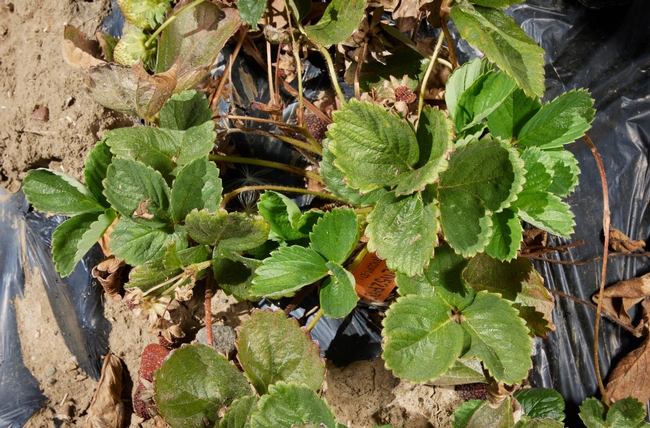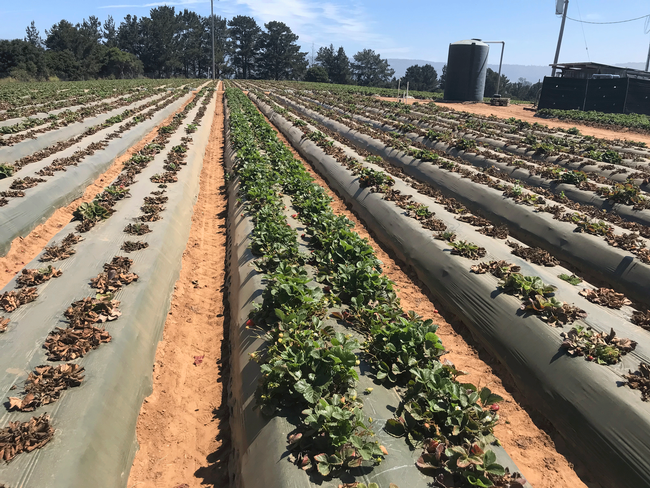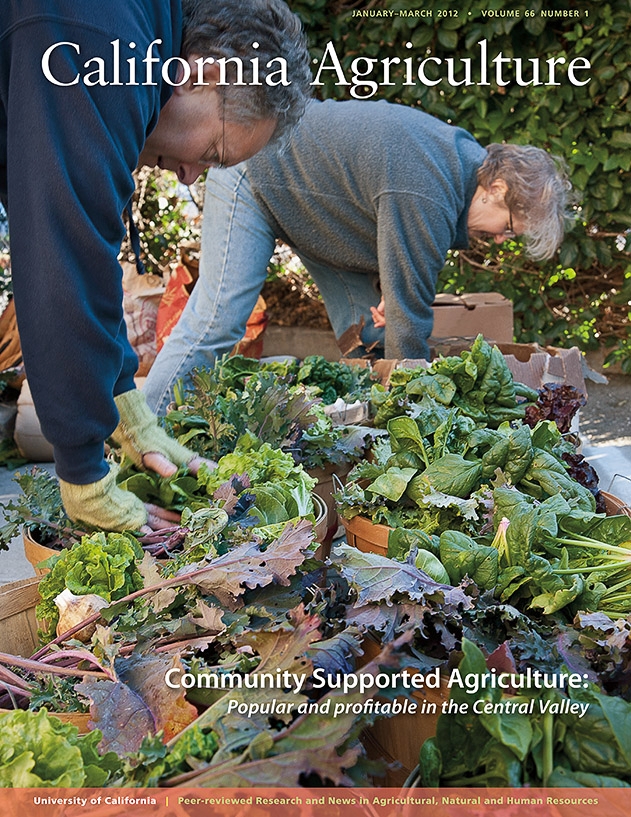Posts Tagged: Fusarium wilt
Researchers identify genes making strawberries resistant to Fusarium wilt
Resistant varieties to be released later this year to growers
Strawberry losses from Fusarium wilt could become less of a threat after researchers at the University of California, Davis, discovered genes that are resistant to the deadly soilborne disease.
The findings, published in the journal Theoretical and Applied Genetics, are the culmination of several years' work, and the discovery will help protect against disease losses, said Steve Knapp, director of the Strawberry Breeding Program at the college.
“What we've accomplished here is important and it's valuable for the industry and it's going to protect growers,” Knapp said.
Strawberries are a key crop in California, where about 1.8 billion pounds of the nutritious fruit are grown each year, making up roughly 88% of what is harvested in the United States.
Finding the genes could prevent a Fusarium wilt pandemic.
“The disease has started to appear more often up and down the state,” said Glenn Cole, a breeder and field manager with the Strawberry Breeding Program. “Once the wilt gets in, the plant just crashes. You have total die out.”
Searching for resistance
UC Davis scientists screened thousands of strawberry plants in the college nursery and took DNA samples. They then used genetic screening and developed DNA diagnostics to identify genes that are resistant to the primary race of Fusarium wilt.
“The genes have been floating around in the strawberry germplasm for thousands of years,” Cole said, but no one worked to identify them.
This latest development brings “strawberry into the 21st century in terms of solving this problem,” Knapp said.
Protecting future crops
This work means breeders can introduce the resistant gene into future strawberry varieties. This fall the program will release new cultivars that have the Fusarium wilt resistance gene. And the DNA diagnostic tools will help breeders respond to new Fusarium wilt variants that develop.
“There will be new threats and we want to be prepared for them,” Knapp said. “We want to understand how this works in strawberries so that as new threats emerge, we can address them as rapidly as possible.”
“If you don't have fusarium resistance, you're done,” Cole said. “The disease could be around more than you think.”
Fusarium wilt hasn't traditionally been an issue but when the fumigant methyl bromide was phased out in 2005, things changed. The disease was in the soil and without the fumigant, instances of wilt increased, especially in areas where crops weren't rotated.
Breeding new varieties
Knapp and Cole have informed the industry about current strawberry varieties that have the resistance so they can select plants with that added protection. The new resistant varieties coming out later this year will be suitable for several growing seasons.
“It's a big deal,” Cole said. “Everything is incremental in plant breeding, but it's a big deal.”
Plant scientists have been breeding strawberries at UC Davis since the 1930s and they have released more than 60 patented varieties through the public breeding program.
All of the work happened at UC Davis. Dominique Pincot, Mitchell Feldmann, Mishi Vachev, Marta Bjornson, Alan Rodriguez, Randi Famula and Gitta Coaker from the Department of Plant Sciences, and Thomas Gordon from the Department of Plant Pathology contributed to the research, as did Michael Hardigan and Peter Henry who are now at the U.S. Department of Agriculture Agricultural Research Service and Nicholas Cobo who is at University of La Frontera in Chile.
The research was funded by UC Davis and grants from the USDA National Institute of Food and Agriculture Specialty Crop Research Initiative.
Integrated approach can reduce the risk of Fusarium wilt in lettuce
In a comprehensive study published in the January-March 2012 issue of the University of California’s California Agriculture journal, researchers evaluated the myriad factors that contribute to crop damage from Fusarium wilt, and conclude that an integrated management approach is most effective.
“Management of Fusarium wilt requires an integrated approach that includes crop rotation to reduce soil inoculum levels and the use of resistant cultivars during the warmest planting windows,” wrote UC Davis plant pathology professor Thomas Gordon and co-authors.
Lettuce is the fifth most valuable agricultural commodity in California, with a farm-gate value of over $1.7 billion in 2009.
Fusarium wilt affects all major lettuce production areas in California and Arizona. Caused by a soilborne fungus, it was discovered in California in 1990, when plants with symptoms that ranged from mild stunting to complete collapse were observed in fields near Huron, in the San Joaquin Valley. Diseased plants have severely rotted taproots.
Crop rotation. While soil fumigation can eradicate the Fusarium fungus, the authors note that reintroduction remains a significant risk and routine preplant fumigation is generally not an option for lettuce because of costs and regulatory restrictions. “Consequently, growers must rely on the attrition of inoculum that occurs naturally when nonsusceptible crops are grown instead of lettuce.”
To estimate the longevity of pathogen propagules, the researchers transported soil from a naturally infested commercial lettuce field in Arizona to establish microplots at the University of Arizona's Yuma Agricultural Center. After 6 and 12 months, the density of the Fusarium fungus had declined by 71 percent and 86 percent, respectively. After 34 months, the fungus was detectable at 0.5 percent of the starting population.
“These results imply that keeping a field free of a susceptible crop for a year should dramatically reduce the density of pathogen inoculum — provided there is no significant reproduction on weeds or a rotation crop — but that the pathogen will likely persist at a low level for at least several years,” Gordon and co-authors wrote in California Agriculture journal.
Field susceptibility. To assess the progression of Fusarium wilt under field conditions, the researchers established an infested plot on the Department of Plant Pathology’s research farm at UC Davis.
The field trials revealed significant differences between cultivars in susceptibility to Fusarium wilt. At three weeks after planting, two leaf lettuce cultivars (Lolla Rossa and Red Rossa) and three romaine cultivars (Caesar, Green Forest and King Henry) had low disease-severity ratings and appeared resistant. Two crisphead lettuce cultivars (Beacon and Early Queen) were highly susceptible, and three other crisphead cultivars (Grand Max, Kahuna and Salinas) were intermediate between these extremes.
By six weeks after planting, differences among the crisphead lettuce cultivars had largely disappeared. Although Salinas and Grand Max were more resistant to Fusarium wilt than other crisphead lettuce cultivars, their level of resistance appeared insufficient to prevent severe damage. On the other hand, leaf and romaine cultivars retained low severity ratings until the end of the season.
Air temperature. Air temperatures also played an important role in disease development. In the field trials at UC Davis, Fusarium wilt developed more rapidly in the first (June) trial than in the second (July) and third (August) trials. Air temperatures were highest during the June planting, with a mean daily high/low of 99°F/59°F. They were progressively lower during trials in July, 95°F/55°F, and August, 90°F/52°F. Additional temperature tests in controlled environment chamber confirmed a significant effect of temperature on the development of Fusarium wilt, with disease being most severe at the highest temperatures.
Genetic research. The research team has identified additional resistant romaine and red leaf cultivars and begun developing populations to determine the genetic basis of their resistance. Likewise, breeding is under way to transfer the resistance genes from highly resistant crisphead cultivars to less resistant types.
“The process is time consuming, so it will be several years before highly resistant crisphead cultivars are available,” the authors note. “In the future, highly resistant cultivars of multiple types will be available for vulnerable production areas and warm periods of the season.”
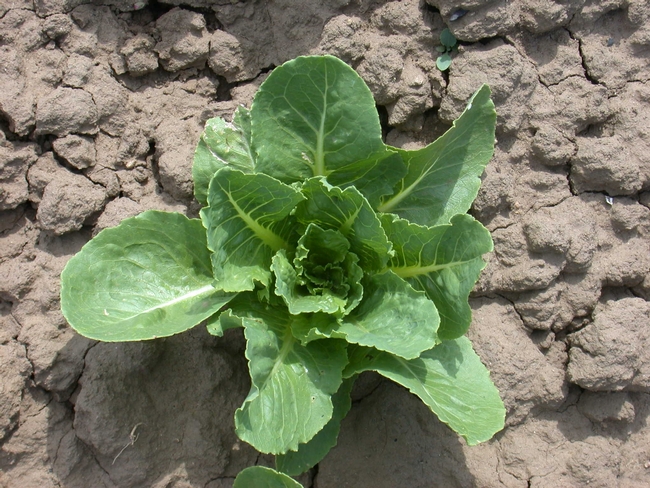
In soils infested with the Fusarium fungus, 'Caesar' lettuce was highly disease resistant.
Community Supported Agriculture grows rapidly in California’s Central Valley
Community Supported Agriculture (CSA) — farms that regularly provide fresh produce directly to members — is growing rapidly in California’s Central Valley and surrounding foothills, according to a new study published in the January–March 2012 issue of the University of California’s California Agriculture journal.
Total membership in the CSAs surveyed (n = 46) increased exponentially from an estimated 672 members in 1990 to 32,938 members in 2010. Most CSAs in California’s Central Valley and surrounding foothills were relatively small (20 acres on average), produced a broad range of crops (44 on average) and adhered to organic or sustainable growing practices.
Likewise, 54 percent of the CSA farms surveyed were profitable; of the rest, 32 percent broke even and 15 percent operated at a loss. Gross average sales for the CSAs surveyed were $9,084 per acre in 2009; this compares with average gross sales of $1,336 per acre for California agriculture in general.
Despite their increasing popularity, little is known about CSA farmers and their operations. UC researchers conducted a comprehensive study of CSA farmers in the Central Valley and surrounding foothills about their growing practices, farm economics, demographics and other characteristics. The article in full and the entire January–March 2012 issue of California Agriculture can be found at: http://californiaagriculture.ucanr.org.
CSAs eliminate distributors, forging direct connections between farmers and consumers; California has about 275 CSAs, and there are more than 3,500 nationally. The researchers found that CSAs are adapting and changing to meet consumer interest in and demand for locally produced food.
“Together with farmers markets, farm stands, U-picks and agritourism, CSAs constitute a ‘civic agriculture’ that is re-embedding agricultural production in more sustainable social and ecological relationships, maintaining economic viability for small- and medium-scale farmers and fulfilling the non–farm-based population's increasing desire to reconnect with their food,” Ryan Galt, UC Davis assistant professor in the Department of Human and Community Development, and co-authors wrote in California Agriculture journal.
The CSA model has undergone considerable change and innovation, the researchers found, with growers offering new products such as meat and dairy and making payment options more attractive to consumers. When the first CSAs were started on the East Coast in the mid-1980s, members paid in advance and received a share of the farm’s crop in return, and they also shared in production risks. Today’s CSAs allow consumers more flexibility and less risk. “Twenty percent of CSAs in the study had no minimum payment period, allowing week-by-week payments, which extends membership to a broader population, including those hesitant or unable to commit to extended payments,” the authors wrote.
The study team also interviewed CSA farmers about what motivated them. “Even though a CSA is hard work, farmers tend to find it rewarding,” Galt and co-authors noted. “The vast majority were happy with their work and continued to view the CSA as a viable option for small- and medium-scale farmers.”
Also in the January–March 2012 issue of California Agriculture:
Farm-to-WIC study: The federal Special Supplemental Nutrition Program for Women, Infants and Children (WIC) now distributes monthly cash vouchers to low-income women with children to buy fruits and vegetables. UC Cooperative Extension (UCCE) researchers surveyed WIC participants in Tulare, Alameda and Riverside counties in 2010 to guide the development of a farm-to-WIC program that would connect local growers to the WIC market. Based on WIC participants’ produce preferences and buying habits, they developed a list of 19 produce items for possible inclusion in the program, including broccoli, cabbage, collards, nopales, sweet potato and tomatillo.
Preventing Fusarium wilt of lettuce: Caused by the soilborne fungus Fusarium oxysporum f. sp. lactucae, Fusarium wilt affects all major lettuce production areas in California and Arizona. In trials at UC Davis, lettuce cultivars differed significantly in susceptibility to the disease, with some leaf and romaine types highly resistant under all test conditions. Management of Fusarium wilt requires an integrated approach that includes crop rotation to reduce soil inoculum levels and the use of resistant cultivars during the warmest planting windows.
Also in the online-only E-Edition of California Agriculture:
Biological control for citrus pests: In a spring 2010 survey and statistical analysis, growers with greater citrus acreage and more education were more likely to use biological controls for four important citrus pests (California red scale, citrus red mite, citrus thrips and cottony cushion scale). Marketing outlets, ethnicity and primary information sources also influenced the extent of reliance on beneficial insects.
California Agriculture is the University of California’s peer-reviewed journal of research in agricultural, human and natural resources. For a free subscription, go to: http://californiaagriculture.ucanr.org, or write to calag@ucdavis.edu.
WRITERS/EDITORS: To request a hard copy of the journal, e-mail jlbyron@ucdavis.edu.

